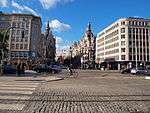Antwerp diamond district
Coordinates: 51°12′52″N 4°25′07″E / 51.214425°N 4.418625°E


Antwerp's diamond district, also known as the Diamond Quarter (Diamantkwartier), and dubbed the Square Mile[1] is an area within the city of Antwerp, Belgium. It consists of several square blocks covering an area of about one square mile. While, as of 2012, much of the gem cutting and polishing work historically done in the neighborhood had moved to low wage centers elsewhere, about 84% of the world's rough diamonds passed through the district, making it the largest diamond district in the world with a turnover of 54 billion dollars.[2]
Over $16 billion in polished diamonds pass through the district's exchanges each year. There are 380 workshops that serve 1,500 companies. There are also 3,500 brokers, merchants & diamond cutters.
Within the area is the Antwerp World Diamond Centre, and four trading exchanges[3] including the Diamond Club of Antwerp and the Beurs voor Diamanthandel, both of which were founded by Hasidic diamantaires,[4] the Antwerpsche Diamantkring and the Vrije Diamanthandel.[5] There are also four banks specializing in the financing of the diamond trade.[6]
The neighborhood is dominated by Jewish, Indian, Lebanese Maronite Christian and Armenian dealers, known as diamantaires.[7] [7] [8] More than 80% of Antwerp's Jewish population work in the diamond trade; Yiddish was, historically, a main language of the diamond exchange.[9] No business is conducted on Saturdays.[10]
Location
The diamond district is located adjacent to the Central Station (Antwerp Centraal) and a few minute's walk to Meir, Antwerp's main shopping street. The Antwerp Zoo is also nearby. There are numerous and various restaurants, bars and cafes around the district.[11] Restaurants include: Ho Chan House (Chinese), San Remo and Da Vinci Pizzerias. Bars include: Bier Central (boasts over 200 types of beers), Kelly's Irish Pub. Cafes include: Del Rey.
History
Antwerp has been a focus of the diamond trade for several centuries; the industry was transformed when Lodewyk van Berken invented a new form of diamond polishing tool, the scaif, which enabled the creation of the stereotypical sparkling, multifaceted diamond; this attracted orders from European nobility - and attracted other craftsmen to Antwerp.[12] Charles the Bold commissioned him to cut and polish the Florentine Diamond. In the 1890s a diamond industry is established in Antwerp by families of diamonds traders and manufacturers who came from Amsterdam, Netherlands.[13]
See also
- Antwerp Diamond Bank
- Diamond Exchange District - Israel
- Diamond District - New York City
- Antwerp Diamond Heist
- Kimberley Process Certification Scheme
- Jewelers' Row, Philadelphia
References
- ↑ Organized Crime: Culture, Markets and Policies By J. M. Nelen, p90
- ↑ John Tagliabue (November 5, 2012). "An Industry Struggles to Keep Its Luster". The New York Times. Retrieved November 6, 2012.
- ↑ Minerals Yearbook 2008: Area Reports, International, Europe and Central Eurasia, Volume 3, By Interior Department (COR)
- ↑ Diamond Bourses in Antwerp Diamond District Archived August 23, 2011, at the Wayback Machine.. Allaboutgemstones.com. Retrieved on 2011-06-02.
- ↑ The industry | Antwerp World Diamond Centre
- ↑ The Heart of the Matter: Sierra Leone, Diamonds and Human Security By Ian Smillie, Lansana Gberie, Partnership Africa Canada, Ralph Hazleton, p27
- 1 2 Antwerp Diamond District. Virtual Globetrotting (2007-03-31). Retrieved on 2011-06-02.
- ↑ Recession takes the sparkle out of Antwerp's diamond quarter | World news. The Guardian. Retrieved on 2011-06-02.
- ↑ Jewish Quarter and Diamond Quarter - Antwerp, Belgium. Sacred-destinations.com. Retrieved on 2011-06-02.
- ↑ A travel guide to Jewish Europe By Ben G. Frank, p311
- ↑ "Visit Antwerp". Antwerp World Diamond Centre. Retrieved 2016-10-26.
- ↑ Edward Jay Epstein (1982). The Diamond Invention. Hutchinson. p. 272. ISBN 0091476909.
- ↑ "Diamonds in Geneva". DiamAlps.